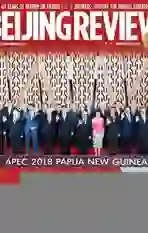An Artistic Enclave
2018-12-15ByCraigCrowther
By Craig Crowther
For a European more familiar with the streets of Berlin than Beijing, the expanse and somewhat illogical composition of this city can be both disquieting and diffi cult to manage. While Beijing does boast a historical center in the iconic Forbidden City, today it has developed into a series of sprawling neighborhoods connected by colossal ring roads and highways. Flanked by skyscrapers, towering offi ce blocks and residential buildings, Beijing can often feel elusive of intimacy, verve and creativity, which are ever present in Londons Soho, New Yorks Metropolitan Avenue and Bangkoks bustling Silom Road. In search of an antidote, I found myself on a bright, autumnal Sunday at the 798 Art District in Chaoyang District of east Beijing.
The plans for this much-needed factory complex originated in the early 1950s, when China turned to the German Democratic Republic to assist with its construction. The result of such an influence is a series of mega structures in the traditional German Bauhaus style, a combination of arts and crafts. More than just a factory, 798 became a quasi-city in its own right. Inexpensive accommodations were provided for workers as well as recreational activities such as sports and literary clubs.
The factory was critical for providing material and equipment for some of Beijings most important landmarks such as the WorkersStadium in todays Sanlitun and the Great Hall of the People in Tiananmen Square. As Beijings modernization and urbanization continued, the sites importance declined and was eventually rendered obsolete.
When experimental artists began looking for new spaces, 798 became populated with sculptors, painters, writers and a myriad of other creative types. Over the past decade it has witnessed rapid growth and today, is the citys premier art district encompassing galleries, coffee shops, boutique stores and kitsch bars. Take a stroll through the narrow alleys and streets bustling with trendy locals and you could mistakenly think youre rambling around Hamburgs coolest kiez or Manchesters hip Northern Quarter.
While unquestionably urban, the 798 buildings have been excellently refurbished with not just functionality but also aesthetics in mind. A walk across the largely pedestrianized road from a quirky café to a thoughtprovoking gallery is a far cry from the rest of Beijing, which normally requires something akin to a city triathlon involving a bike, train and a perilous game of traffi c dodging to go from one place to the next.
Places with such an emphasis on aesthetics are a rarity in Beijing. With the city expanding at such a rapid rate, there has been little time for incorporating such tropes, with the focus being primarily on the practical. It is a well-documented fact that our surrounds have a profound effect on us. A considered environment has multiple benefits including improved mental health, a more educated and engaged mindset, greater self-refl ection and an improved sense of society.
While homesickness wasnt a common feature of my extensive time spent abroad, since arriving in Beijing, I have had a distinct longing to escape the races-style traffic and concrete. So 798 was a welcome rest. Designated a tourist attraction, its actually the size of a small British town and you can easily spend a day here, browsing the many galleries and stopping for a craft beer along the way. There are other areas too which focus on creating a vivacious social space—Wudaoying Alley located near Beijings Lama Temple is teeming with character. But none are as extensive or impressive as 798.
Beijing is certainly not short on excellent bars, superb restaurants and other amenities which expats frequently hanker when living in foreign climes. But the development of areas such as 798 offers a slice of serenity for both the international community and locals, making Beijing both a more livable and gratifying place to be.
